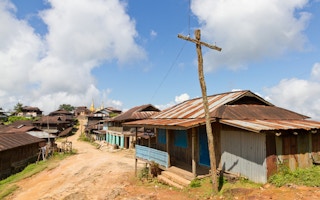Two of the heaviest hitters within the international development world — the United Nations and the World Bank — recently came together to underscore their efforts to activate financing dedicated to delivering modern energy access by 2030 to the one in five people globally currently living without electricity.
World Bank Group President Jim Yong Kim made it clear that an additional $600-$800 billion a year between now and 2030 will be needed from government, international agencies, civil society and the private sector to achieve universal electrification, as well as double renewable energy adoption and energy efficiency.
What hasn’t yet been made clear is how that financing will be targeted. Historically, donor aid and financing has spent hundreds of billions of dollars on energy infrastructure — but oftentimes the rural poor don’t reap the benefits. Only eight per cent of the World Bank’s energy financing in 2012 targeted the poor.
“
In fact, if universal electrification has a chance to be achieved, 55 per cent of all new power between now and 2030 must come from decentralised energy sources with 90 per cent of it being renewable, according to the International Energy Agency
Emphasizing decentralised energy
Given that the majority of the 1.4 billion people without electricity live in rural, dispersed communities, it would be wise for the international development community to mobilize energy access strategies that reflect this reality by supporting off-grid renewable energy.
In fact, if universal electrification has a chance to be achieved, 55 per cent of all new power between now and 2030 must come from decentralised energy sources with 90 per cent of it being renewable, according to the International Energy Agency (IEA).
According to the IEA, the lion’s share of all new power generation (42 per cent) will need to come from mini-grid systems if universal electrification is to be reached by 2030. It’s clear: Renewable energy-based mini-grids stand at the top of the list of how electrification in the developing world can best be targeted.
Why mini-grids?
Mini-grids — powered purely by renewable energy or hybridized for reliability with diesel generators — can be deployed faster than a centralized grid, have the flexibility to upgrade capacity to meet a community’s increased energy demands and can interface with the national grid when and if it reaches the area. Why wait years or decades for the national grid to arrive when the same level of electricity can be provided within a few months?
The efficacy and level of energy access must also be considered. The IEA suggests a minimum threshold of about 100 kWh of electricity per person, per year if “modern” energy access is to be achieved. Solar lanterns and standalone solar home systems are valuable stepping stones that provide lighting, phone charging and even the occasional television, but economic and social development will be limited if there isn’t sufficient energy supply for productive uses such as powering rice mills, carpentry tools, vaccine refrigerators or irrigation pumps. Mini-grids can offer the level of electricity needed for such progress.
From a human and economic development perspective, community-based operational models for mini-grids — in which locals are provided technical and accounting skills to manage a system — open the opportunity for local enterprise and new income generation. Combining energy access, human capacity building and microenterprise is a powerful tool.
Enabling factors
In addition to funding and finance, other pieces of the puzzle are also necessary if universal energy access can be achieved. Innovative business models and new technology for mini-grids continue to emerge. Leading development institutions are increasingly putting mini-grids on the agenda (here, here and here, for example), but the momentum needs to continue building.
Next, governments and policymakers need to create enabling environments for decentralised energy development by establishing policy, and regulatory frameworks that don’t cater to the traditional, grid-or-nothing approach. Long-term commitments and policies that encourage private sector and investor participation are crucial if off-grid energy solutions, particularly mini-grids, are going to make a widespread impact on eliminating energy poverty.
Myanmar — a country where more than 40 million people aren’t grid-connected — is a prime example. The country is essentially building its electricity infrastructure from the ground up and is in an opportune position to take a decentralised approach to electrification. Not only could the country bring reliable power to its energy-poor population (more than 70 per cent of the country) in a matter of years instead of decades, Myanmar could also become a model for the dozens of other developing nations struggling to develop effective electrification strategies.
As the uphill journey toward universal energy access moves forward — and the UN’s “Decade of Sustainable Energy for All” is rung in at the New Year — the question remains: How quickly can financial institutions, development agencies and governments shift from a fossil-based, centralized-grid mindset, to an off-grid, renewable energy-based paradigm?
Evan Scandling is the head of communications at Sunlabob Renewable Energy. Follow Evan Scandling on Twitter: www.twitter.com/@NWC_Evan. This post originally appeared here.

















